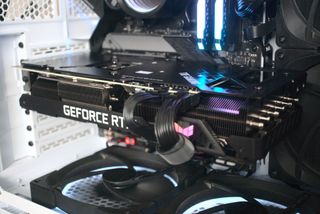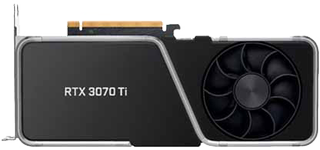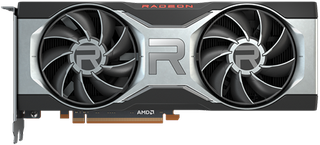

Slightly better than the RTX 3070
The NVIDIA GeForce RTX 3070 Ti is a slight upgrade over the RTX 3070, perfect for anyone who wants just a bit more power. It will deliver better performance in most games at 1440p and 4K compared to the AMD RX 6700 XT, but its list price is also $120 higher. Its DLSS and ray-tracing capabilities are superior to AMD's alternatives.
For
- Better framerates in many games
- DLSS and ray tracing are amazing
- NVIDIA Broadcast
- HDMI 2.1, PCIe 4.0
Against
- Limited availability
- More expensive
- Less VRAM
- Higher power draw

More affordable, still powerful
The AMD Radeon RX 6700 XT isn't quite as powerful as the RTX 3070 Ti but it costs considerably less and draws less power, making it a better pick for the budget-focused gamer. It's capable of ray tracing and it has a DLSS alternative, but neither technology is as mature as what NVIDIA has to offer.
For
- Cheaper starting price
- Still awesome performance
- FidelityFX Super Resolution boosts performance
- Capable of ray tracing
- Lower power draw
Against
- Limited availability
- Not quite as powerful
- Ray-tracing capabilities not as mature
- Super Resolution not as mature as DLSS
Both of these GPUs are among best graphics cards on the market today, though they're equally difficult to source due to global stock shortages. This is slowly starting to change, but shopping is still mostly dire. If you do find one for sale, it will likely be priced far above its actual list price. For the sake of this comparison, we will focus on list prices.
NVIDIA RTX 3070 Ti vs. AMD RX 6700 XT tech specs
| Header Cell - Column 0 | NVIDIA RTX 3070 Ti | AMD RX 6700 XT |
|---|---|---|
| Architecture | Ampere | RDNA 2 |
| Shader/stream | 6,144 | 2,560 |
| Tensor/texture | 192 | 160 |
| Clock | 1.58GHz | 2.3GHz |
| Boost clock | 1.77GHz | 2.5GHz |
| Memory | 8GB GDDR6X | 12GB GDDR6 |
| Bus width | 256-bit | 192-bit |
| Transistors | 17.4B | 17.2B |
| Node | 8nm | 7nm |
| TDP | 290W | 230W |
| Recommended PSU | 750W | 650W |
| Slot size | Two | Two |
| Starting price | $600 | $480 |
Performance and features

These two GPUs are within sight of the high-end performance tier, with each putting up solid numbers at 1440p and 4K. The RTX 3070 Ti is just slightly ahead of the standard RTX 3070, which matches up quite well with the RX 6700 XT. That means you can expect between about 5% and 15% better raw performance from the 3070 Ti in most games at 1440p and 4K. There will be some exceptions based on outside circumstances, but if you're just looking at pure performance without any of the supporting features or costs, go with the 3070 Ti.
A note on resolution: Both GPUs are most comfortable at 1440p, and you'll be able to maximize in-game settings and still get a smooth experience with high frames per second (FPS). Both GPUs will also be able to push 4K, though you'll likely have to turn down in-game settings to achieve the golden 60 FPS or higher. If you're looking to stick with 1080p, you can no doubt go with a cheaper GPU that will still crush AAA games. Check out our NVIDIA RTX 3060 review for more information about such a card.

You know you're going to get marginally better performance from the RTX 3070 Ti, and for some people that's enough. But there are also a bunch of features associated with each GPU that should be examined. Perhaps most importantly are ray tracing and DLSS. NVIDIA introduced these technologies to their RTX 20-series GPUs, allowing for more time to mature now that they've carried over to RTX 30-series cards. AMD added ray tracing support to its RDNA 2 GPUs (including the RX 6700 XT), but it's not as good. Performance generally takes a bigger hit; if you want to enjoy ray tracing in most games, NVIDIA is still the way to go.
NVIDIA's DLSS is standing by in compatible games to significantly boost performance. While AMD lagged behind on this front for quite a while, it recently released FidelityFX Super Resolution, shortened down to FSR. I have an article comparing DLSS to FSR for a deeper look, but the main takeaway here is that while FSR works quite well, it's not available in nearly as many games.
AMD added Infinity Cache to its RDNA 2 GPUs, which is a dense 96MB L3 cache that lowers memory latency. This makes the memory bus sizes a lot closer than they might seem; also note that the RX 6700 XT has 12GB of VRAM while the RTX 3070 Ti has 8GB. If you're planning on keeping the GPU for as many years as possible, you might want to go with the higher amount of VRAM. Smart Access Memory (SAM), which boosts performance in compatible hardware, was unique to AMD for a few months. But NVIDIA has since enabled resizable BAR support in its RTX 30-series GPUs, making this a moot point.
NVIDIA's Broadcast is something that AMD can't compete with. It's a tool for streaming and conferencing that uses AI to enrich video and audio while also eliminating background noise and background. It works like magic most of the time, and it might make you lean toward NVIDIA if you're serious about streaming.
Get the Windows Central Newsletter
All the latest news, reviews, and guides for Windows and Xbox diehards.
Bottom line? NVIDIA's RTX 3070 Ti has slightly better raw performance, and its stable of extra features is more mature. However, the $120 list price difference only gets worse as people jack up prices, and you might find the RTX 3070 Ti well out of your price range. The RX 6700 XT is considerably cheaper, and it's still going to crush 1440p gaming and allow you to get into 4K gaming. As pointed out in our RTX 3070 Ti review, you're likely better off getting an RTX 3070 if you want NVIDIA's features at a similar price as the RX 6700 XT.
Go with the RTX 3070 Ti for better performance, more mature features
The RTX 3070 Ti brings slightly better performance than the RX 6700 XT, and its main extra features (like ray tracing and DLSS) are more mature. However, it costs quite a bit more and might not be worth it for anyone who just wants excellent 1440p performance. Check out our guide on where to buy NVIDIA RTX 30-series GPUs for more information.

The RTX 3070 Ti offers somewhere around 10% average better performance compared to the RX 6700 XT, but it also costs quite a bit more. If you have the budget, the ray tracing and DLSS features should no doubt be quite compelling.
The AMD RX 6700 XT costs less and still crushes 1440p
AMD still has some catching up to do when it comes to ray tracing performance and FSR support, but the RX 6700 XT is still a GPU that can easily handle a high-end 1440p gaming experience. It also costs less than the RTX 3070 Ti, making it the go-to choice for anyone on a tighter budget. Check out our guide on where to buy AMD Radeon RX 6000 GPUs for more information.

Don't care as much about the extra features and just want a GPU that can crush 1440p gaming? The RX 6700 XT will deliver at a far lower price than the RTX 3070 Ti.

Cale Hunt brings to Windows Central more than eight years of experience writing about laptops, PCs, accessories, games, and beyond. If it runs Windows or in some way complements the hardware, there’s a good chance he knows about it, has written about it, or is already busy testing it.
